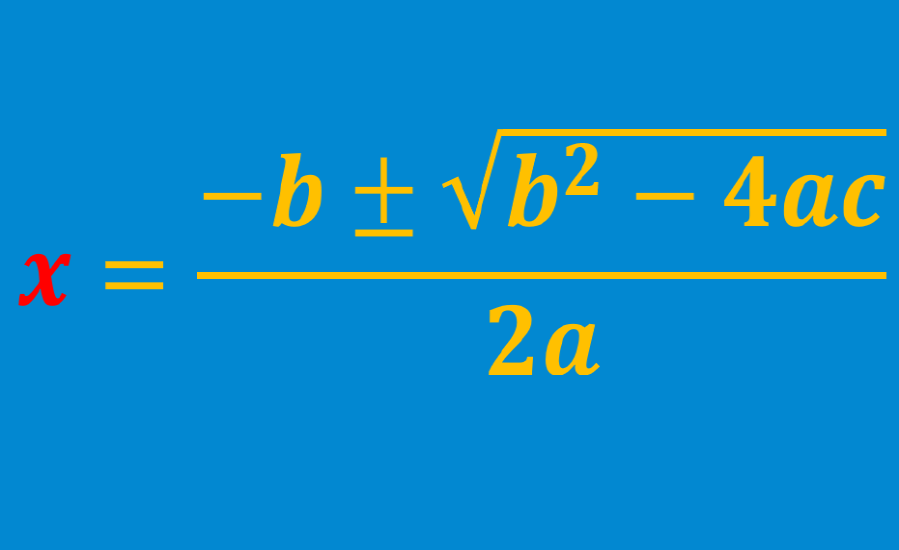The quadratic formula allows us to solve any type of quadratic equation. This formula is extremely useful since some equations cannot be solved by factoring. Here, we will look at a summary of the quadratic formula.
In addition, we will explore various examples with answers that use the quadratic formula in order to fully master solving quadratic equations with this formula.
Summary of the quadratic formula
One of the simplest ways to solve a quadratic equation with the general form $latex a{{x}^2}+bx+c=0$ is by factoring and solving for each factor. However, many times the quadratic equation cannot be factored easily.
In these cases, we can use the general quadratic formula since with this formula, we can find the solutions of any quadratic equation.
The quadratic equation uses the values of the coefficients from the equation, that is, the values of a, b, and c. This formula is derived from the process of completing the square. For a quadratic equation $latex a{{x}^2}+bx+c=0$, the values of x that are the solutions of the equation are given by:
| $latex x=\frac{{-b\pm \sqrt{{{{b}^{2}}-4ac}}}}{{2a}}$ |
For the quadratic formula to work, we must always put the equation in the form “(quadratic) = 0”. In addition, we have to be careful with each of the numbers that we put in the formula. For example, the “2a” is below the entire expression, not just the square root.
Also, we have to always place the “plus/minus” sign since this will allow us to obtain both solutions to the quadratic equation.
Quadratic formula – Examples with answers
The general formula detailed above is used to solve these quadratic equation examples. It is recommended that you try to solve the exercises yourself before looking at the solution.
EXAMPLE 1
Use the quadratic formula to find the solutions to the equation $latex {{x}^2}-4x+3=0$.
Solution
In this equation, we have $latex a=1$, $latex b=-4$ and $latex c=3$. Therefore, replacing these values into the quadratic formula, we have:
$latex x=\frac{{-(-4)\pm \sqrt{{{{{(-4)}}^{2}}-4( 1 )(3)}}}}{{2(1)}}$
$latex =\frac{{4\pm \sqrt{{16-12}}}}{2}$
$latex =\frac{{4\pm \sqrt{{4}}}}{2}$
$latex =\frac{{4\pm 2}}{2}$
$latex =\frac{{4+2}}{2},~~\frac{{4-2}}{2}$
$latex =\frac{{6}}{2},~\frac{2}{2}=3,~1$
Thus, the solutions are $latex x=3$ and $latex x=1$.
EXAMPLE 2
Find the solutions of the quadratic equation $latex {{x}^2}+3x-10=0$.
Solution
Here, we have the coefficients $latex a=1$, $latex b=3$ and $latex c=-10$. Using the quadratic formula with these values, we have:
$latex x=\frac{{-(3)\pm \sqrt{{{{{(3)}}^{2}}-4( 1 )(-10)}}}}{{2(1)}}$
$latex =\frac{{-3\pm \sqrt{{9+40}}}}{2}$
$latex =\frac{{-3\pm \sqrt{{49}}}}{2}$
$latex =\frac{{-3\pm 7}}{2}$
$latex =\frac{{-3+7}}{2},~~\frac{{-3-7}}{2}$
$latex =\frac{{4}}{2},~\frac{-10}{2}=2,~-5$
Therefore, the solutions are $latex x=2$ and $latex x=-5$.
EXAMPLE 3
Solve the quadratic equation $latex 4{{x}^2}+8x-12=0$.
Solution
In this equation, we can recognize the values $latex a=4$, $latex b=8$ and $latex c=-12$. Therefore, using the quadratic formula with these values, we have:
$latex x=\frac{{-(8)\pm \sqrt{{{{{(8)}}^{2}}-4( 4 )(-12)}}}}{{2(4)}}$
$latex =\frac{{-8\pm \sqrt{{64+192}}}}{8}$
$latex =\frac{{-8\pm \sqrt{{256}}}}{8}$
$latex =\frac{{-8\pm 16}}{8}$
$latex =\frac{{-8+16}}{8},~~\frac{{-8-16}}{8}$
$latex =\frac{{8}}{8},~\frac{-24}{8}=1,~-3$
Thus, the solutions are $latex x=1$ and $latex x=-3$.
EXAMPLE 4
Find the solutions to the equation $latex 3{{x}^2}-7x-6=0$.
Solution
In this case, we have the values $latex a=3$, $latex b=-7$ and $latex c=-6$. Therefore, substituting these values in the formula, we have:
$latex x=\frac{{-(-7)\pm \sqrt{{{{{(-7)}}^{2}}-4( 3 )(-6)}}}}{{2(3)}}$
$latex =\frac{{7\pm \sqrt{{49+72}}}}{6}$
$latex =\frac{{7\pm \sqrt{{121}}}}{6}$
$latex =\frac{{7\pm 11}}{6}$
$latex =\frac{{7+11}}{6},~~\frac{{7-11}}{6}$
$latex =\frac{{18}}{6},~\frac{-4}{6}=3,~-\frac{2}{3}$
Thus, the solutions are $latex x=3$ and $latex x=-\frac{2}{3}$.
EXAMPLE 5
Find the solutions to the quadratic equation $latex 4{{x}^2}+12x+9=0$.
Solution
Using the values $latex a=4$, $latex b=12$ and $latex c=9$ with the general quadratic formula, we have:
$latex x=\frac{{-( 12 )\pm \sqrt{{{{{(12)}}^{2}}-4( 4)(9)}}}}{{2(4)}}$
$latex =\frac{{-12\pm \sqrt{{144-144}}}}{8}$
$latex =\frac{{-12\pm \sqrt{{0}}}}{8}$
$latex =\frac{{-12\pm 0}}{8}$
$latex =\frac{{-12}}{8}=-\frac{{3}}{2}$
We see that we obtained a zero within the square root. This means that we do not get any change when adding or subtracting zero. Therefore, the only solution is $latex x=-\frac{{3}}{2}$.
EXAMPLE 6
Find the solutions to the quadratic equation $latex 2{{x}^2}+4x+8=0$.
Solution
We can identify the values $latex a=2$, $latex b=4$ and $latex c=8$. Therefore, using the general quadratic formula with these values, we have:
$latex x=\frac{{-( 4 )\pm \sqrt{{{{{( 4)}}^{2}}-4( 2)( 8 )}}}}{{2( 2 )}}$
$latex =\frac{{-4\pm \sqrt{{16-64}}}}{4}$
$latex =\frac{{-4\pm \sqrt{{-48}}}}{4}$
In this case, we got a negative number inside the square root. We know that we cannot solve this if we are restricted to real numbers. Therefore, we can simply say that this equation has no real solutions.
However, if we have knowledge of complex numbers, we can solve the equation as follows:
$latex =\frac{{-4\pm \sqrt{{-48}}}}{4}=\frac{{-4\pm 4\sqrt{{-3}}}}{4}$
$latex =\frac{{-4\pm 4\sqrt{{3}}i}}{4}$
$latex =-1\pm \sqrt{3}i$
Therefore, the solution of these types of equations depends on whether we are restricted to real numbers or if we can also consider complex numbers:
Only real numbers: there is no solution.
Complex numbers: the solution is $latex =-1\pm \sqrt{3}i$.
Quadratic formula – Practice problems
Use the general quadratic formula to solve the following problems. Choose the answer and check it to verify that you selected the correct one. Check out the solved exercises above in case you need help.
See also
Interested in learning more about factoring and the quadratic formula? Take a look at these pages:




